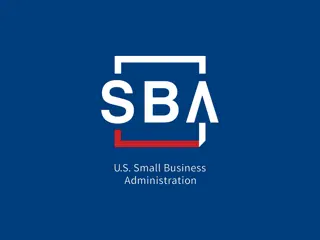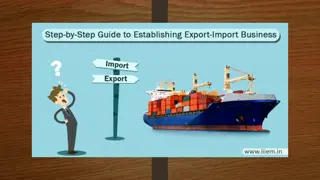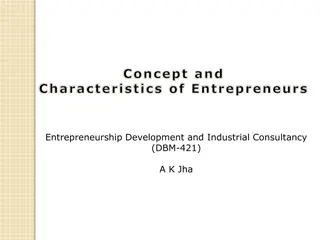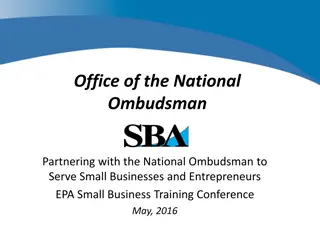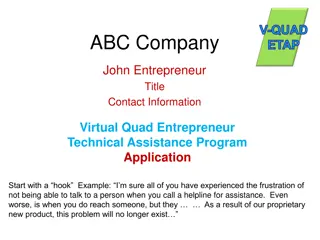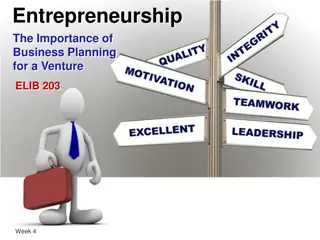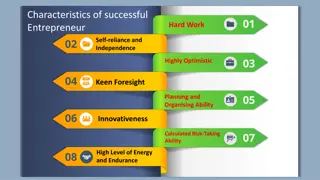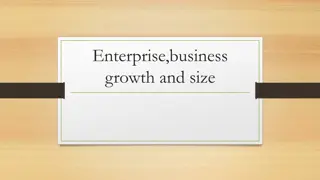The Importance of a Well-Written Business Plan for Entrepreneurs
Understanding the significance of a well-structured business plan is crucial for entrepreneurs. It serves as a planning tool, formal requirement for various business activities, and instills discipline and structure. Despite its benefits, business plans have drawbacks such as time commitment, barriers to starting, and needing constant revision. Before starting a business plan, considerations like non-disclosure agreements and audience targeting are essential.
Download Presentation

Please find below an Image/Link to download the presentation.
The content on the website is provided AS IS for your information and personal use only. It may not be sold, licensed, or shared on other websites without obtaining consent from the author. Download presentation by click this link. If you encounter any issues during the download, it is possible that the publisher has removed the file from their server.
E N D
Presentation Transcript
The The Importance Importance of of a a Well Business BusinessPlan Plan(BP) Well Written Written (BP) PRESENTED BY IAN JUUL 1
Introduction - my past businesses include; 1. Selling Wild Birds aged 10 2. Accounting / Consulting Practice - Sold 3. Telephone Meters / Electronic Ballasts - Sold 4. Accounting / Consulting Practice - Sold 5. Panel Manufacture / Fabrication - Sold 6. Sports Clothing Embroidery (NIKE, Adidas, Wilson etc) - Sold 7. Wooden Furniture from Indonesia Failed / Liquidated 8. Accounting / Consulting Practice Closed 9. Removals / Storage Sold 10. Advertising Magazine - Failed 11. Consultant London - Closed 12. Restaurant Spain - Sold 13. Retail Gift Shop Florida - Sold My family were also Entrepreneurs (property development, African artifacts, mining, farming, fast food, timber logging, haulage) Small Business Development Corporation 7 years. Investigated around 15 Businesses a month lending Money, mentorship and support programs. Lent between $ 5,000 and $ 2 million. Lent $$ to hawkers in squatter camps to global businesses (Nando s / KFC). 2
Why do you need a Business Plan ? 1. Planning Tool - Forces you to consider a wide range of factors that potentially impact the viability of your business. It is a formal Checklist have I considered everything ? 2. Formal requirement Applying for finance, negotiating rental contracts, negotiating supply contracts, looking for investors & partners and even Customers sometimes ask for your BP eg RFP Process / Tenders & Bids. 3. Creates discipline & structure It tests those wild ideas and brings a measure of reality to the conceptual process. Often Entrepreneurs run ahead of themselves and a BP forces them to get real and find solutions. Ideally the BP should be a detailed written document. In reality, BP s are usually fragmented ideas and they are not committed to writing. This poor practice increases risk. 3
The negative sides of a BP The negative things about a BP are; 1. They take time to complete. BP s are commitment of time and sometimes cost. 2. Barrier to starting business. A new business is exciting and taking time-out to complete a BP seems like an obstacle & causes a delay. 3. They outdate quickly. Business is dynamic with constant changes, so a BP needs constant revision and this gets tiring. 4. Confidentiality risks Intellectual Property. All your research and ideas can be misused. 5. Criticism Sharing a BP invites Criticism and not everybody likes Criticism. 4
Before you Start Before you start the BP consider; 1. Non-disclosure Agreement (NDA) Get your own simple NDA and get any-one who reads your BP to first commit to an NDA. An NDA offers some protection. 2. Who is your audience CRITICAL. Tailor the BP to your audience. A bank is going to be looking at short- term EBITA (earnings before interest and tax) and loan securities, whilst a potential Angel Investor will be looking at medium to long-term ROI (return on investment) over a certain period. A leasing agent will be looking at what product lines you are selling so that he can leverage and balance a tenant mix in a Mall, whilst a Distributor will be looking at what product volume you can move. 3. Size. A small business needs a smaller BP. A larger business needs a larger BP. 4. Your business type. A retailer will concentrate on local competition, demographics, inventory turnover ratio, trading hours etc whilst a manufacturer will concentrate on machine capacity, quality, work flows, logistics. ONE SIZE does-not fit all. 5
Step 1 Break Even Analysis The essence of business is the flow of money from your customers to your vendors and you are trying to keep as much of this money flow as you can. B/E Analysis it is probably the most important Business Calculation you need to learn. B/E Analysis estimates the Sales you need to BreakEven ie. Using the money you collect from your Customers as Sales, you can pay your running costs and Vendors. B/E requires estimating your monthly running costs and dividing this by your Gross Profit Percentage. Eg. Costs are $ 15,000 a month and GP is 60 %, the B/E point will be 15,000 / 60 % = $ 25,000 per month or around $ 5,800 per week or $ 1,000 a day and X per hour etc. Learn about Gp % age and determining your Expenses. 6
Step 2 Using B/E Analysis Once you have calculated your B/E analysis you use it for; 1. Sensitivity Analysis If I increase my monthly expenses by employing one more person, how much more in Sales do I need to generate to cover this extra Payroll. Payroll increase is $ 5,000 and Gp % age is 60 % - New Sales required is $ 8,333 per month or $ 1,924 a week. If I save $ 5,000 per month, I need $ 8,333 pm less in sales to Break Even. 2. Competitor Analysis If you employ 5 staff and rent 3,000 Sq Ft shop and your competitor employs 10 staff and 5,000 Sq Ft logic says that your competitor s B/E point must be at least 100 % / double what yours is. This helps estimate Market size ? 3. Bench-marking - Your B/E point helps you benchmark your Business. Compare yourself against the competition, it helps with your Financial planning (how much Working Capital do I need) and it also helps bench mark work and capacities If I need $ 25,000 a month to B/E and I am selling $ 5 items that is nearly 200 items a day. I need X staff, X inventory, X floor area etc 7
Step 3 The traditional B/P Components Once you are confident that you can easily exceed your B/E point, then progress to completing the traditional components of a BP which include a detailed synopsis of; 1. Key Owners and Management The quality of management will determine the success of the business. The second biggest reason for business failure is, poor management skills. Include Resumes etc of key owners and managers. 2. Marketing Marketing Mix (Product, Place, Promotion, Price), Demographics, Location, Competition, Marketing Plans etc. 3. Technical Manpower, Permits, Capacity, Manufacturing issues, Quality, Logistics etc. 4. Financial B/E Analysis, Cash Flow Forecast, Funding, Balance Sheet, Profit & Loss, Ratios, Statistics etc 5. SWOT Analysis (Internal - Strengths, Weaknesses, Opportunities, Threats) and maybe a PEST Analysis (External - Political, Economic, Social, Technological). 8
Step 4 Review & Revisit Once you have completed your BP and covered everything that you think you need to address, please review the BP with people who are suitably placed to Review it before you share the BP. Welcome Criticism Criticism may hurt but it helps you become better. Take the advice, re- visit and re-plan. Remember to use the NDA for any-one reviewing the BP. Revisit and update the BP on a regular basis. Business environment is very dynamic, so regularly review and adjust your BP. 9
Questions? Thank you. 10

 undefined
undefined


 undefined
undefined








